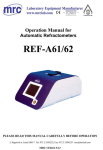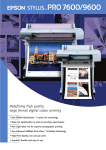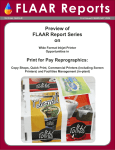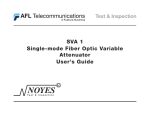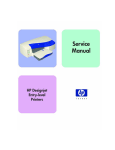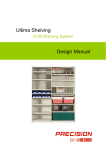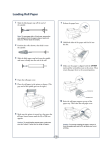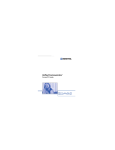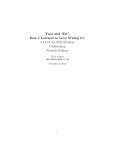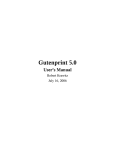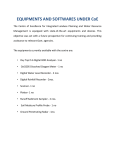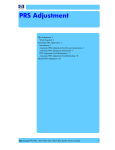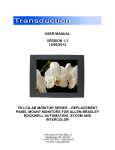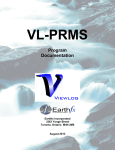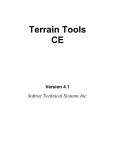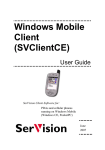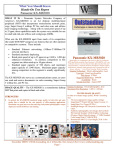Download QEA Image Analysis System
Transcript
Reports QEA Image Analysis System Qualitative Analysis Patrick Lichty F L AAR RE P O RT S A Qualitative Analysis Quality Engineering Associates, Inc. Personal Image Analysis System Patrick Lichty Report 2004 FLAAR Digital Imaging Resource Center QEA Personal Image Analysis System Introduction One of the most important concerns for any print operation is that of consistency and quality control. QC is one of the foundations of creating a uniformly solid product, maximizing customer satisfaction. However, a great deal of Image Quality Assurance is done by ‘eyeballing’ print quality, which is invariably subjective in nature. To assure quality, output is usually sent to labs specializing in the objective (quantitative) analysis of the print image. But for facilities who frequently check their output quality, or for companies who wish consistently quick turnaround of Topics lab results, in-house solutions might be more cost effective or attractive. Installation QEA’s Personal Image Analysis System combines a high-quality digital microscope, powerful image analysis software, and an embedded PocketPC with synchronization capability with Microsoft Office. This hardware/ Features software combination allows for detailed analysis of inkjet and electrostatic Tech Support printing, including tests for dot, line, text, and area quality, tone reproduction, Overall Evaluation and print defects. Instead of using subjective means for judging the quality of a given print, the IAS allows for the precise measurement of print quality using established ISO (International Standards Organization) criteria. The IAS will be able to inform the print operator not only when a printer is creating a properly formed print, more importantly, it will tell the operator when the print is being executed properly. Accessories A representative from QEA meets with BGSU professor Chuck Spontelli and Large Format Lab Manager Brent Cavanaugh. © Copyright 2004 by FLAAR, 111 Saddlemire, Bowling Green, Ohio 43403 FLAAR is a non-profit educational and research institute that nurtures the global market for large format digital imaging, by providing objective information to help consumers select products and use them more effectively, and by facilitating the development of new technologies, which will better serve the needs of consumers. 3 FLAAR Digital Imaging Resource Center QEA Personal Image Analysis System Platforms Supported to a PC through the USB port, although screen updates to the PC can take up to 10 seconds. The Image Analysis System is a self-contained unit incorporating a fully-featured PocketPC, powerful digital microscope, and image analysis software bundle. However, if the user wishes to download image samples and test data, they can transfer this information to MS Office through Active Sync software. In addition, live test information can be presented through connection Interfaces: USB 1.0 Installation For those familiar with the operation of a Pocket PC, and a Casio Cassiopeia E-125 in particular, the installation of the QEA software is easily done through the use of a Flash RAM cartridge. An Adobe Acrobat version of the manual, as well as backups of the IAS software, which can be installed through Microsoft ActiveSync, is available on the companion CD. Again, even though the IAS is a standalone unit, users not familiar with the basic operation of Pocket PC’s would benefit greatly in familiarizing themselves with the PPC’s functions and Active Sync. The user would then be able to benefit more fully from the use of the Pocket PC at the heart of the system as well as the analyzer, thus greatly enhancing the value of the system. 4 FLAAR Digital Imaging Resource Center QEA Personal Image Analysis System Documentation The IAS comes with two copies of the User’s Manual, one hardcopy, and another on the Companion CD. In addition, the IAS comes with a set of reference images to help the user familiarize themselves with the unit. associated tutorials. The rest of the manual covers a brief introduction to Pocket PC operation, customizing the IAS, and appendices on troubleshooting and explanations of print standards. The manual is straightforward; the basic operations of the IAS are covered in a concise thirty pages, and the rest of the manual consists of discussions of the various Image Quality Analysis (IQA) tests and Accessories Features The IAS comes with a lens cleaning cloth, power supply, USB hookup cable and reference images, as well as the manual and Companion CD. The IAS offers a wide variety of functions for the objective (quantitative) analysis of print quality. This includes dot, line, area quality, etc. The tests that the IAS offers focus on inkjet and electrostatic (tonerbased) printers,but could be used in some offset print applications. QEA being represented at the TIARA Conference. 5 FLAAR Digital Imaging Resource Center QEA Personal Image Analysis System Additional Features Features (cont.) • • • • • • • Dot quality Diameter Perimeter Area Circularity • • • • • • Line quality (uses ISO-13660 methods) Line width Line density Blurriness Edge raggedness Contrast Fill Area quality (uses ISO-13660 methods) Reflectance Visual Density Color Density (Status T, Status A, DIN, DIN-NB) Color (HSI and L*a*b*) Uniformity (graininess and mottle) Tone reproduction Reflectance and density % area coverage Dot gain Graininess and mottle Image defects Intercolor bleed Satellites Voids Extraneous marks Background Text quality Stroke width and density Edge raggedness MTF (modulation transfer function) Region of Interest-based analysis from live or stored image Two-point distance measurement Auto/manual color plane selection Auto line orientation detection Indication of Pass/Fail tolerances Statistics and graphical plots ActiveSync with laptop or PC The IAS test results can also be transferred as database or text files for later review or incorporation into reports. Captured images used in analysis can be saved as well. Tech Support Although the manual recommends trying to resolve any issues by working through its Troubleshooting appendix first, QEA does offer technical support from their Boston offices. The Technical Support number is not toll-free, and hours are not listed on the website. 6 FLAAR Digital Imaging Resource Center QEA Personal Image Analysis System Usage Notes it is reasonable to assume that a new user could sit down in an afternoon, or at most a day, and become familiar with the IAS. The author of this report was able to pick up the IAS, read the manual, and begin to do some initial testing of the supplied reference sheets within three hours. However, the embedded Casio E-125 PocketPC is the exact same model in the author’s possession, and he had been making cursory examinations of the machine and materials for a couple weeks. From this Overall Evaluation actual meaning of the data had not been defined. At a list price of $9,995, it’s assumed that the technician using the IAS would be very familiar with ISO and ANSI print standards, but perhaps a couple pages in the manual on evaluation methods would be helpful for junior The IAS is a relatively easy device to learn, and is a snap to work with, especially for those who are familiar with Pocket PC’s using Windows CE. It has an intuitive interface, offers quick image analysis that can be transferred to most Windows machines as databases and image captures. The software also plots image histograms (which are explained clearly in the manual) that give a quick, intuitive overview of print quality regarding line sharpness, text quality, satellites (dot spatter), and many other Image Quality Analysis print criteria. technicians. Chuck Spontelli and Brent The IAS uses Cavanaugh test the IAS on a Casio E-125 sample media. Pocket PC as the heart of its system. This particular system uses Windows CE as its operating system, and the latest version of the PPC windows platform is currently PocketPC2002. The E-125 is a capable PDA, and users will be able to share analysis data with all their Microsoft Office software. However, users wishing to run some of the newer PPC programs may not be However, the IAS also assumes that the user is familiar with print quality standards, and “knows what they’re looking for”. In this case, the author, with no prior knowledge of these standards, was able to learn basic principles of many of the tests from the documentation. In addition, relative baselines for other quantitative print standards were determined from working with the device and the reference sheets, although the 7 FLAAR Digital Imaging Resource Center QEA Personal Image Analysis System able to do so if they are PPC2002-specific. QEA does not plan to go to PPC 2002 in the near future, and most users will most likely not use the embedded PDA outside of its dedicated use in the IAS. Therefore, the use of Windows CE should not present any problems, but is worthy to note. The IAS was easy to use, intuitive, and very flexible in terms of numbers of tests available to the user. For facilities wishing to monitor their print production FLAAR employee demonstrates quality assurance the usability of the interface on the IAS. in their inkjet and electrostatic equipment without hiring outside labs for costly QA testing, the IAS could pay for itself quickly in terms of print consistency (customer satisfaction), as well as costly lab outsourcing. Although QEA’s Image Analysis System does not completely replace the functions of a lab for quality control analysis, it can perform most testing functions for the monitoring of a facility for a reasonable price. 8 FLAAR Digital Imaging Resource Center QEA Personal Image Analysis System Case Study with QEA Image Analysis System Product Specifications Purpose To create a report that compares the print quality of the Epson Stylus Pro 7600 to the HP Designjet 130nr using quantitative measurements from the QEA Personal Image Analysis System (IAS) and qualitative using reference images in both Black & White and Color. Epson Stylus Pro 7600 • Ink: 7 Color UltraChromeTM Pigment • Printhead: Micro Piezo DX3TM • Speed: Production Quality 87ft2 per hour Assignment • Resolution: Maximum 2880x1440 dpi First, ensure both printers are reasonably color calibrated and aligned. Use a similar surface media in both printers, but use branded media. Print out the QEA Target PDF on both printers. Use the QEA Personal IAS to measure the targets. Report results and compare performance. • Media Input: Up to 24” Width Roll or Sheet • Media Used: Epson Premium Luster Photo Paper • Standard EPSON ESC/P Raster Photographic Driver Hewlett-Packard Designjet 130nr Second, select 5 representative images, including black & white and color photographs, and print on both printers. Compare performance in quality and speed. Write a report detailing your procedures and findings. 9 • Ink: 6 Color Dye Based • Printhead: HP Thermal Inkjet • Speed: Production Quality 4 pages per minute • Resolution: Maximum 2400x1200 dpi • Media Input: Up to 24.6” x 69.3” Sheet, 24” Roll • Media Used: HP Premium Plus Photo Satin • HP Designjet 130 Software RIP FLAAR Digital Imaging Resource Center QEA Personal Image Analysis System Introduction Results Like many of today’s printing technologies, Inkjet manufacturers have continued to develop new or improved ways of increasing speed, quality and overall color reproduction that are directed toward individuals or small businesses. Two printers currently on the market that have been labeled as such are the Epson Stylus Pro 7600 and the Hewlett-Packard Designjet 130nr. Both of these printers are large format printers stated by their manufacturers to have the best photographic reproduction in their product category. The major areas of testing were done with Dot Circularity and Consistency, Line Width, Contrast and Density and the Modulation Transfer Function (MTF). These tests are all outlined in the QEA Personal Image Analysis System User’s Guide. Text clarity was also evaluated using a visual comparison. The User’s Manual states that the dot is the most elemental building block for all high level image content. By testing these dots, we are able to see the quality of the image. The basic dot analysis can be used to record many other image quality attributes. I used this Dot Analysis, along with the other tests to record our findings. The quantitative data will then help us understand the qualitative data better. Epson claims that the Stylus Pro 7600 can “produce incredibly sharp text and line art that rivals a final press sheet.” Another claim by Epson states you can see “no signs of ink jet technology.” According to the User’s Manual Dot Analysis, the Circularity of the image should (ideally) be 1. If the circle is in a different shape, the measurement is greater than 1, but if the circle is small, the test may be inaccurate and register with a measurement less than 1. To test the dots, you should at least take a sample size of 9 dots; any less may not give accurate information. These dots should be small enough to fit on the screen and big enough to register using the Above is a sample image taken QEA Personal IAS. from the QEA IAS during the To select the Region testing of the HP and Epson printers. of Interest (ROI), you can use the touch screen or just select Full Size ROI in the options menu. It is best to use the full view when testing dots and the MTF because it can Meanwhile, Hewlett-Packard is taking the position of long-lasting, fade-resistant photo quality. The new ink technology used in the HP 130nr is stated to have almost doubled the life of the print. The combination of HP media and new inks should give prints a life up to 70 years in normal lighting conditions. HP also promotes their printer has a high color stability, as well as consistency. In addition, by using their HP printer specific media, the prints should have a uniform gloss. By performing these evaluations and reporting my findings, I hope to be able to determine which printer is better, based solely on the data analyzed and images produced. Of course, one printer may meet the user’s needs better than the other, but my research will choose the overall better printer based on its performance. 10 FLAAR Digital Imaging Resource Center QEA Personal Image Analysis System of the lines. I chose to measure the 1pt. line. A 1pt. line is approximately .357mm in width. The calculations done by the QEA Personal IAS read that the HP 130nr had a horizontal line width of .457mm, one tenth of a millimeter larger than of an actual 1pt. line. The HP 130nr line was also very crisp and clear with very minimal blurring or raggedness. In relation to the Epson 7600, the HP 130nr has 20% less blur and half the amount of ragged edges. If you take a close look at the pictures, you can see that the lines are similar in size, but due to the blurring of the Epson line, the actual line width was measured at .321mm, less than the size of a 1 pt. line. As you can also see by the illustration, the line density, or darkness of the line, is far greater in the line produced by the HP 130nr than the Epson 7600. Because this line is much darker, the contrast of the HP 130nr line is also greater than that of the Epson 7600. pick up more data in a larger area. Once you have selected and measured the dots, the data needs to be interpreted. Circularity should be tested first. From the results, the HP 130nr has an average circularity of 1.59 and a standard deviation of .09. This means that the dots produced by the HP 130nr are very close to printing out in a circular shape. Also, by recording a value of .09 as a standard deviation, it tells us that the dots are very similar in shape and size. The low standard deviation and the similarity of the size and shape of the dots show us that the dot reproduction is consistent. As you can clearly see by the illustration, the screen capture of the dots printed using the HP 130nr look very much like circles. These dots are .4mm in diameter. On the other hand, the Epson 7600 reproduced the dots with a Circularity Measurement of 2.98 and a standard deviation of .98. It was very hard for the QEA device to measure these 9 dots accurately. The screen capture kept selecting the satellites and measuring them as dots. (Satellites are extraneous marks around the dots or other printed defects that can cause inaccurate measurements.) However, I was able to increase the minimum measurable dot size to eliminate these errors. The data recorded by the QEA Personal IAS shows that the .4mm dots are oddly shaped and inconsistently reproduced. You can see in the image that the Epson 7600 dots are much less circular and a lot more blurry than those of the HP 130nr dots. The MTF Test displayed very similar results to the Line Analysis. The MTF tests are used to quantify the resolution of the printer. The User’s Manual states that by measuring the contrast in patterns of lines printed at various frequencies, in lines per millimeter, the QEA Personal IAS can evaluate special details in an image. To test, there are two methods, the standard formula and the QEA formula. The QEA formula was chosen for this evaluation because it depicts the actual average contrast between the printed lines and the paper on a 100% reflectance scale. Also, when using the QEA formula, the MTF values are more sensitive to the deterioration of resolution as line frequency increases. When comparing the graphs produced by the MTF results, the results showed that the printers were very close. I found this to be very surprising The next quantitative test performed was the Line Analysis, measuring the width, contrast and density 11 FLAAR Digital Imaging Resource Center QEA Personal Image Analysis System The final quantitative test was done by a visual comparison of text clarity. The reason for testing this way is the fact that any text printed smaller than 8 point on the Epson 7600 was unable to register using the QEA Personal IAS. When taking a look at the screen captures made by the QEA Personal IAS, you are able to see that the text is almost illegible on the Epson but very readable on the HP 130nr. If you have good eye sight, you are even able to read the 2 pt. font off of the HP paper without a magnifying glass and have the text decipherable. Any text printed under 8pts. on the Epson 7600 would be unrecognizable to the naked eye. Even with the magnification of the QEA device, it was because the images looked nothing alike. Again, with the Epson 7600 lines, they appeared to be Above is a sample image taken thinner than the HP from the QEA IAS during the 130nr lines due to MTF testing of the HP and Epson printers. the blur and ragged edges. With that, the Epson had much more surface reflectance between lines when the line frequency was low, while, as the other results have shown the HP 130nr out performed the Epson when it comes to the finer details. The HP 130nr had better results as the line frequency increased, while at lower line frequencies, the Epson 7600 performed better than the HP 130nr. As you can see by the screen captures, the HP 130nr lines are consistent, which is what the Epson 7600 has been lacking in the previous tests. These screen captures were taken from the 3rd highest hard to read the ragged text. line frequency. CLICK HERE TO ACQUIRE FLAAR REPORTS Digitizing Scanning Color Managing RIPing Printing Laminating & Trimming Please realize that all reports are in Adobe Acrobat PDF format. The reader software is free from www.adobe.com/products/acrobat/readstep2.html PDF files are intended to be read on your computer monitor. Naturally you can print them if you wish, but if the photographic images within the reports were high enough dpi for a 1200 dpi laser printer it would not be possible to download them. So the images are intended to be at monitor resolution, naturally in full color. FLAAR itself makes the files available only in PDF format because that is the international standard. We have no mechanism to print them out and mail them. Obviously if you have downloading problems we will try to help, but please realize that we assume you have a 56K modem (or better) and capabilities to handle a basic PDF file. Copyright 2002-2005 Nicholas Hellmuth-FLAAR First issued 2002. Updated September 2003, Most recently updated January 2005. 12












